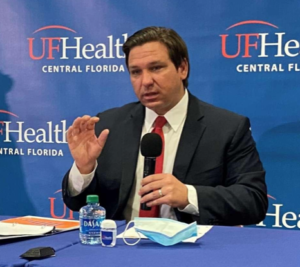By John Haughey
The Center Square
January 29, 2021

Florida Gov. Ron DeSantis released his $96.6 billion fiscal year 2022 budget request Thursday, setting the stage for months of negotiations with state lawmakers over the state’s next spending plan.
DeSantis’ “Florida Leads” budget proposal increases spending over fiscal year 2021’a $92.3 billion budget by $4.3 billion, or 4.65%.
“While this is an increase of $4.3 billion over the current fiscal year, $2.6 billion accounts for various expenditures related to the state’s COVID-19 pandemic response and its impacts on Floridians,” the budget request said.
The governor’s budget request proposes $33.8 billion for Medicaid, $22.8 billion for K-12 public schools, $9.47 billion for roads and infrastructure, $625 million for water quality improvements, $423.3 million for workforce and affordable housing and $65 million in tax cuts.
DeSantis’ budget proposal includes “more than $1 billion in savings – including more than $400 million in administrative and operational efficiencies” – to increase state reserves to $6.6 billion and leave “ample resources for unforeseen expenditures related to the COVID-19 pandemic and 2021 hurricane season.”
Fiscal year 2022 begins July 1. Highlights of the governor’s budget request, which will serve as the template for budget deliberations by state lawmakers when their session convenes March 2, include:
• Medicaid: DeSantis is seeking $33.788 billion for the Florida Agency for Health Care Administration (AHCA), which manages the state’s Medicaid program, representing a $3 billion increase.
As of late December, 4.44 million Floridians were enrolled in the state Medicaid program, an increase of 450,000 since July 1. State economists project Medicaid enrollment could swell by another 700,000 people by 2022.
• Education: The budget request seeks a state-record $22.8 billion in spending for K-12 public schools, including $12.9 billion in state funding, to raise the state’s per-student allocation by $233 to $8,019 each.
DeSantis wants $550 million, an increase of $50 million, to continue increasing teachers’ salaries to a $47,500 base.
“As the COVID-19 pandemic has affected students in unimaginable ways, the budget includes $110 million for mental health programs in Florida’s schools, an increase of $10 million over current year funding,” the request states.
• Environment: Lawmakers have approved the first two years of DeSantis’ four-year, $2.5 billion water quality plan. The governor is requesting its third $625 million allocation, which proposes $473 million for Everglades restoration, $50 million for springs restoration, $145 million for “targeted” projects and $25 million to combat algal blooms and red tide.
The budget request “tackles the challenges of sea level rise, intensified storm events, and localized flooding” by establishing the Resilient Florida program, which will provide $1 billion over the next four years to protect vulnerable properties.
The governor also seeks “$82 million to protect Florida’s prized properties and waterbodies,” including $50 million for Florida Forever and $32 million for infrastructure improvements.
• Tax relief: DeSantis calls for $65 million in tax cuts, including a $56 million, eight-day Back-to-School Sales Tax Holiday and a $9 million, 10-day Disaster Preparedness Sales Tax Holiday “to ease Floridians’ tax burden.”
• Economic development: The governor wants $50 million for the Job Growth Grant Fund, $50 million for VISIT FLORIDA, $50 million for the Economic Development Transportation Fund and $5 million for Enterprise Florida Inc. “to engage in targeted campaigns that market the opportunities available in Florida for businesses to realize economic and job growth in the state.”
• Cybersecurity: DeSantis’ budget proposal dedicates nearly $40 million to enact upcoming recommendations from the state’s Cybersecurity Task Force to “take action in protecting the state against cyber threats that can compromise critical resources and information.”
